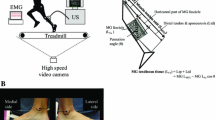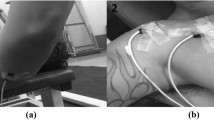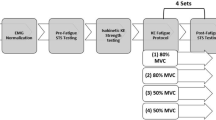Abstract
Knee extensor and elbow flexor muscles have been demonstrated to have similar fatigability, i.e. time to task failure at submaximal force level, in healthy non-trained individuals. This experiment investigated if continuative endurance training can influence the fatigability of these two muscle groups in amateur runners. Surface electromyography was used to assess fatigability in twelve amateur runners. Participants were requested to sustain for 30 s the 70 % of their maximum voluntary contraction of knee extensor and elbow flexor muscles. During contractions, electromyographic signals were recorded, respectively, from vastus lateralis and biceps brachii muscles with linear array of eight electrodes. Muscle fiber conduction velocity (CV), mean power spectral frequency (MNF), and fractal dimension (FD) of electromyographic signals were calculated. During the sustained contraction vastus lateralis muscle showed smaller decrease of CV (p = 0.006), MNF (p = 0.001), and FD (p = 0.001) than biceps brachii muscle. The lower fatigability found in knee extensors than in elbow flexors suggests that the physiological adaptation promoted by the endurance training was specific to the musculature involved in the training (i.e. the lower limbs).

Similar content being viewed by others
References
Frey Law LA, Avin KG (2010) Endurance time is joint-specific: a modelling and meta-analysis investigation. Ergonomics 53(1):109–129. doi:10.1080/00140130903389068
Fuglevand AJ, Zackowski KM, Huey KA, Enoka RM (1993) Impairment of neuromuscular propagation during human fatiguing contractions at submaximal forces. J Physiol 460:549–572
Hunter SK, Critchlow A, Shin IS, Enoka RM (2004) Men are more fatigable than strength-matched women when performing intermittent submaximal contractions. J Appl Physiol 96(6):2125–2132. doi:10.1152/japplphysiol.01342.2003
Avin KG, Naughton MR, Ford BW, Moore HE, Monitto-Webber MN, Stark AM, Gentile AJ, Law LA (2010) Sex differences in fatigue resistance are muscle group dependent. Med Sci Sports Exerc 42(10):1943–1950. doi:10.1249/MSS.0b013e3181d8f8fa
Burke RE, Levine DN, Tsairis P, Zajac FE 3rd (1973) Physiological types and histochemical profiles in motor units of the cat gastrocnemius. J Physiol 234(3):723–748
Yassierli Nussbaum MA, Iridiastadi H, Wojcik LA (2007) The influence of age on isometric endurance and fatigue is muscle dependent: a study of shoulder abduction and torso extension. Ergonomics 50(1):26–45. doi:10.1080/00140130600967323
Hunter SK, Ryan DL, Ortega JD, Enoka RM (2002) Task differences with the same load torque alter the endurance time of submaximal fatiguing contractions in humans. J Neurophysiol 88(6):3087–3096. doi:10.1152/jn.00232.2002
Clark BC, Collier SR, Manini TM, Ploutz-Snyder LL (2005) Sex differences in muscle fatigability and activation patterns of the human quadriceps femoris. Eur J Appl Physiol 94(1–2):196–206. doi:10.1007/s00421-004-1293-0
Hunter SK, Enoka RM (2001) Sex differences in the fatigability of arm muscles depends on absolute force during isometric contractions. J Appl Physiol 91(6):2686–2694
Place N, Maffiuletti NA, Ballay Y, Lepers R (2005) Twitch potentiation is greater after a fatiguing submaximal isometric contraction performed at short vs. long quadriceps muscle length. J Appl Physiol (1985) 98(2):429–436. doi:10.1152/japplphysiol.00664.2004
Enoka RM (2012) Muscle fatigue—from motor units to clinical symptoms. J Biomech 45(3):427–433. doi:10.1016/j.jbiomech.2011.11.047
Marcora SM, Staiano W (2010) The limit to exercise tolerance in humans: mind over muscle? Eur J Appl Physiol 109(4):763–770. doi:10.1007/s00421-010-1418-6
Merletti R, Rainoldi A, Farina D (2001) Surface electromyography for noninvasive characterization of muscle. Exerc Sport Sci Rev 29(1):20–25
Merletti R, Farina D, Gazzoni M (2003) The linear electrode array: a useful tool with many applications. J Electromyogr Kinesiol 13(1):37–47
Merletti R, Knaflitz M, De Luca CJ (1990) Myoelectric manifestations of fatigue in voluntary and electrically elicited contractions. J Appl Physiol 69(5):1810–1820
Merletti R, Roy S (1996) Myoelectric and mechanical manifestations of muscle fatigue in voluntary contractions. J Orthop Sports Phys Ther 24(6):342–353
Boccia G, Dardanello D, Rinaldo N, Coratella G, Schena F, Rainoldi A (2015) Electromyographic manifestations of fatigue correlate with pulmonary function, 6-min walk test, and time to exhaustion in COPD. Respir Care 60(9):1295–1302. doi:10.4187/respcare.04138
Beck TW, Ye X, Wages NP (2015) Local muscle endurance is associated with fatigue-based changes in electromyographic spectral properties, but not with conduction velocity. J Electromyogr Kinesiol 25(3):451–456. doi:10.1016/j.jelekin.2015.02.006
Rainoldi A, Galardi G, Maderna L, Comi G, Lo Conte L, Merletti R (1999) Repeatability of surface EMG variables during voluntary isometric contractions of the biceps brachii muscle. J Electromyogr Kinesiol 9(2):105–119
Kupa EJ, Roy SH, Kandarian SC, De Luca CJ (1995) Effects of muscle fiber type and size on EMG median frequency and conduction velocity. J Appl Physiol 79(1):23–32
Sadoyama T, Masuda T, Miyata H, Katsuta S (1988) Fibre conduction velocity and fibre composition in human vastus lateralis. Eur J Appl Physiol Occup Physiol 57(6):767–771
McCarthy JP, Pozniak MA, Agre JC (2002) Neuromuscular adaptations to concurrent strength and endurance training. Med Sci Sports Exerc 34(3):511–519
Vila-Cha C, Falla D, Farina D (2010) Motor unit behavior during submaximal contractions following 6 weeks of either endurance or strength training. J Appl Physiol 109(5):1455–1466. doi:10.1152/japplphysiol.01213.2009
Wasserman K (1984) The anaerobic threshold measurement to evaluate exercise performance. Am Rev Respir Dis 129(2 Pt 2):S35–S40
Hermens HJ, Freriks B, Disselhorst-Klug C, Rau G (2000) Development of recommendations for SEMG sensors and sensor placement procedures. J Electromyogr Kinesiol 10(5):361–374
Beretta Piccoli M, Rainoldi A, Heitz C, Wuthrich M, Boccia G, Tomasoni E, Spirolazzi C, Egloff M, Barbero M (2014) Innervation zone locations in 43 superficial muscles: toward a standardization of electrode positioning. Muscle Nerve 49(3):413–421
Gitter JA, Czerniecki MJ (1995) Fractal analysis of the electromyographic interference pattern. J Neurosci Methods 58(1–2):103–108
Mesin L, Cescon C, Gazzoni M, Merletti R, Rainoldi A (2009) A bi-dimensional index for the selective assessment of myoelectric manifestations of peripheral and central muscle fatigue. J Electromyogr Kinesiol 19(5):851–863. doi:10.1016/j.jelekin.2008.08.003
Boccia G, Dardanello D, Beretta-Piccoli M, Cescon C, Coratella G, Rinaldo N, Barbero M, Lanza M, Schena F, Rainoldi A (2016) Muscle fiber conduction velocity and fractal dimension of EMG during fatiguing contraction of young and elderly active men. Physiol Meas 37(1):162–174. doi:10.1088/0967-3334/37/1/162
Neyroud D, Ruttimann J, Mannion AF, Millet GY, Maffiuletti NA, Kayser B, Place N (2013) Comparison of neuromuscular adjustments associated with sustained isometric contractions of four different muscle groups. J Appl Physiol (1985) 114(10):1426–1434. doi:10.1152/japplphysiol.01539.2012
Yan Z, Okutsu M, Akhtar YN, Lira VA (2011) Regulation of exercise-induced fiber type transformation, mitochondrial biogenesis, and angiogenesis in skeletal muscle. J Appl Physiol (1985) 110(1):264–274. doi:10.1152/japplphysiol.00993.2010
Pietrangelo T, Mancinelli R, Doria C, Di Tano G, Loffredo B, Fanò-Illic G, Fulle S (2012) Endurance and resistance training modifies the transcriptional profile of the vastus lateralis skeletal muscle in healthy elderly subjects. Sport Sci Health 7:19–27. doi:10.1007/s11332-012-0107-8
Mannion AF, Dumas GA, Stevenson JM, Cooper RG (1998) The influence of muscle fiber size and type distribution on electromyographic measures of back muscle fatigability. Spine (Phila Pa 1976) 23(5):576–584
Schiaffino S, Reggiani C (2011) Fiber types in mammalian skeletal muscles. Physiol Rev 91(4):1447–1531. doi:10.1152/physrev.00031.2010
Coyle EF (2005) Improved muscular efficiency displayed as Tour de France champion matures. J Appl Physiol (1985) 98(6):2191–2196. doi:10.1152/japplphysiol.00216.2005
Costill DL, Daniels J, Evans W, Fink W, Krahenbuhl G, Saltin B (1976) Skeletal muscle enzymes and fiber composition in male and female track athletes. J Appl Physiol 40(2):149–154
Casale R, Rainoldi A, Nilsson J, Bellotti P (2003) Can continuous physical training counteract aging effect on myoelectric fatigue? A surface electromyography study application. Arch Phys Med Rehabil 84(4):513–517. doi:10.1053/apmr.2003.50083
Melchiorri G, Rainoldi A (2008) Mechanical and myoelectric manifestations of fatigue in subjects with anorexia nervosa. J Electromyogr Kinesiol 18(2):291–297. doi:10.1016/j.jelekin.2006.10.002
Falla D, Rainoldi A, Merletti R, Jull G (2003) Myoelectric manifestations of sternocleidomastoid and anterior scalene muscle fatigue in chronic neck pain patients. Clin Neurophysiol 114(3):488–495
Pedrinelli R, Marino L, Dell’Omo G, Siciliano G, Rossi B (1998) Altered surface myoelectric signals in peripheral vascular disease: correlations with muscle fiber composition. Muscle Nerve 21(2):201–210
Boccia G, Coratella G, Dardanello D, Rinaldo N, Lanza M, Schena F, Rainoldi A (2016) Severe COPD alters muscle fiber conduction velocity during knee extensors fatiguing contraction. COPD:1–6. doi:10.3109/15412555.2016.1139561
Merletti R, Farina D, Gazzoni M, Schieroni MP (2002) Effect of age on muscle functions investigated with surface electromyography. Muscle Nerve 25(1):65–76. doi:10.1002/mus.10014
Bazzucchi I, Felici F, Macaluso A, De Vito G (2004) Differences between young and older women in maximal force, force fluctuations, and surface EMG during isometric knee extension and elbow flexion. Muscle Nerve 30(5):626–635. doi:10.1002/mus.20151
Bazzucchi I, Marchetti M, Rosponi A, Fattorini L, Castellano V, Sbriccoli P, Felici F (2005) Differences in the force/endurance relationship between young and older men. Eur J Appl Physiol 93(4):390–397. doi:10.1007/s00421-004-1277-0
Fluck M (2006) Functional, structural and molecular plasticity of mammalian skeletal muscle in response to exercise stimuli. J Exp Biol 209(Pt 12):2239–2248. doi:10.1242/jeb.02149
Fluck M, Hoppeler H (2003) Molecular basis of skeletal muscle plasticity–from gene to form and function. Rev Physiol Biochem Pharmacol 146:159–216. doi:10.1007/s10254-002-0004-7
Hargreaves M, McKenna MJ, Jenkins DG, Warmington SA, Li JL, Snow RJ, Febbraio MA (1998) Muscle metabolites and performance during high-intensity, intermittent exercise. J Appl Physiol (1985) 84(5):1687–1691
Schmitz JP, van Dijk JP, Hilbers PA, Nicolay K, Jeneson JA, Stegeman DF (2012) Unchanged muscle fiber conduction velocity relates to mild acidosis during exhaustive bicycling. Eur J Appl Physiol 112(5):1593–1602. doi:10.1007/s00421-011-2119-5
Brody LR, Pollock MT, Roy SH, De Luca CJ, Celli B (1991) pH-induced effects on median frequency and conduction velocity of the myoelectric signal. J Appl Physiol 71(5):1878–1885
Gonzalez-Izal M, Malanda A, Gorostiaga E, Izquierdo M (2012) Electromyographic models to assess muscle fatigue. J Electromyogr Kinesiol 22(4):501–512. doi:10.1016/j.jelekin.2012.02.019
Kauffman LH (1986) The fractal geometry of nature—Mandelbrot, B. J Soc Biol Struct 9(1):33–36
Beretta-Piccoli M, D’Antona G, Barbero M, Fisher B, Dieli-Conwright CM, Clijsen R, Cescon C (2015) Evaluation of central and peripheral fatigue in the quadriceps using fractal dimension and conduction velocity in young females. PLoS One 10(4):e0123921. doi:10.1371/journal.pone.0123921
Coronell C, Orozco-Levi M, Mendez R, Ramirez-Sarmiento A, Galdiz JB, Gea J (2004) Relevance of assessing quadriceps endurance in patients with COPD. Eur Respir J 24(1):129–136
Bawa P, Pang MY, Olesen KA, Calancie B (2006) Rotation of motoneurons during prolonged isometric contractions in humans. J Neurophysiol 96(3):1135–1140. doi:10.1152/jn.01063.2005
Taylor JL, Gandevia SC (2008) A comparison of central aspects of fatigue in submaximal and maximal voluntary contractions. J Appl Physiol 104(2):542–550. doi:10.1152/japplphysiol.01053.2007
Anderson T (1996) Biomechanics and running economy. Sports Med 22(2):76–89
Acknowledgments
We would like to thank Valentina Bellini, Valeria Rosso, and Emma Colamarino for their valuable help in data collection. The help of Corrado Cescon for the signal processing was much appreciated.
Author information
Authors and Affiliations
Corresponding author
Ethics declarations
Conflict of interest
The authors declare no conflict of interest.
Ethical approval
The study was approved by the local ethical committee (Department of Neurological, Neuropsychological, Morphological and Movement Sciences, University of Verona) and performed in accordance with the Helsinki Declaration.
Informed consent
All participants provided their written informed consent before participation in the experiments.
Rights and permissions
About this article
Cite this article
Boccia, G., Dardanello, D., Tarperi, C. et al. Lower fatigability of locomotor than non-locomotor muscles in endurance runners. Sport Sci Health 12, 369–375 (2016). https://doi.org/10.1007/s11332-016-0297-6
Received:
Accepted:
Published:
Issue Date:
DOI: https://doi.org/10.1007/s11332-016-0297-6




